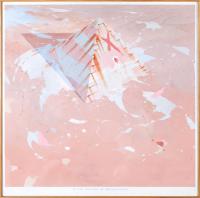Illustrated: "Point to Point. The Art of Tim Storrier" by Linda Van Nunen, Published by
Craftsman House 1987, Page 67.
Tim Storrier was the youngest artist ever to win a major Australian art
prize. At just 19, he was awarded the Sulman Prize in 1968 - an important
moment he credits with giving him the impetus to pursue painting
professionally. Since that early success, Storrier has held 68 solo
exhibitions, won the Archibald Prize for Portraiture twice, claimed a
second Sulman Prize, and served as a trustee of the Art Gallery of New
South Wales. Despite being a seven-time finalist in the Wynne Prize for
Landscape Painting, that particular award has eluded him - at least for
now.
...
In recognition of his contribution to contemporary art, Storrier was
appointed a Member of the Order of Australia (AM) in 1994. He was later
awarded an Honorary Doctorate of Arts from Charles Sturt University in
2003. His works are held in all major state galleries, the National Gallery
of Australia, and internationally at the Metropolitan Museum of Art in New
York.
Storrier’s career is defined by both skill and relentless dedication.
“To the Innuendo of Impermanence”
is one of his transitional works, marking his shift from modernism toward a
more surreal image. Art critic Ruth Faerber described these transitional
pieces as
“Romantic and Surreal... they present the Australian outback as a
fairy-tale oasis, like a mirage in a clear blue sky.”
Rendered with precision and symbolic richness, Storrier’s paintings from
this era are bathed with light and atmosphere. In
“To the Innuendo of Impermanence”
, the landscape is without horizon or sky - an intentional omission that
intensifies the viewer's focus. Through sheer technical mastery, he
transforms the mundane into the interesting. For Storrier, it was never
about the subject itself; rather, it was mood and the arrangement of colour
that gave his work its authority.
Storrier’s work offers something rare: a seamless blend of intellectual
depth, technical brilliance, and open character. His paintings do not
merely depict the Australian landscape - they distil it into something
timeless, evocative, and profoundly personal. In every work, there lies a
quiet invitation to look closer, to linger, and ultimately, to wonder.
Read more


